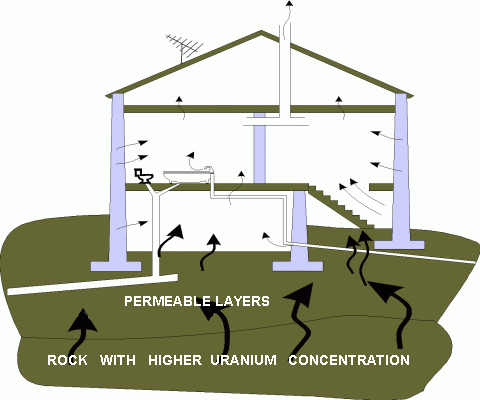Radon can enter a house:
The most significant radon source is the house substratum (i.e., soil). The normal radon concentrations in a depth of 1 metre under the earth's surface are usually higher than 10,000 Bq/m3. The entry of radon into a house is significantly affected by soil gas permeability (i.e., the higher permeability, the higher risk), or by rock defects under the house. All pieces of land are classified into three categories of radon risk (that is, low, middle, and high risk) according to the measured value of radon concentration under the earth's surface and according to soil gas permeability (see further).
Radon can enter a house from soil in two ways:
- Radon is sucked into the house through a number of different leaks in the contact area between the house and soil as a consequence of natural negative pressure that arises in the house, especially in the heating season (so-called stack effect). The bulk of radon enters the house in such a way.
- Radon penetrates by diffusion through the floor and masonry of the contact area into the house. However, this is a less significant process.
Another radon source is building material This is material with higher uranium/radium concentrations from which radon continuously is generated. Such materials, e.g., slag, fly ash, etc., could be used in some locations. For building materials that are used for the construction of houses, the critical limits for the specific radium concentrations are determined: 150 Bq/kg (if a significant quantity of the building material is used in construction, for example, bricks, etc.) and 200 Bq/kg for the other products.
Water supplied, from which radon can release during showering, washing and cooking, is the third possible source of radon in houses. Underground water shows the specific concentrations ranging from 10 to 1,000 Bq/l. Water with a radon concentration higher than 1,000 Bq/l should not be used for individual supply, and water with a radon concentration higher than 300 Bq/l must not be supplied to the public water mains. For example, it is assumed that water with a radon concentration of 10 Bq/l will cause an increase of the long-term mean radon concentration in the air by 1 Bq/m3 on average. For a short time, for example, during showering in a closed bathroom, a remarkable increase of the current radon concentration may appear; however this is not significant from the standpoint of human exposure in houses.
Note: In addition to radon, the other radionuclides, for example, radium, uranium and the other isotopes, can be found in water, and their concentrations must be monitored and reduced (see Regulation no. 307/2002 Coll.)
Variations of radon concentrations in indoor air
Radon concentration in indoor air varies during the day and night, individual days, yearly seasons, and also years. Radon concentrations are in particular affected by:
- Ventilation changes
- Radon supply changes
Active radon suction into a house (i.e., "stack effect") from soil plays the most significant role in radon supply. This suction increases with an increasing difference between outdoor and indoor temperatures, which results in negative pressure in the dwelling. Hence, the maximum radon supply into the dwelling may be observed by night and in the early hours of the morning, and more or less this results in a regular variation of radon concentrations during day and night. For the same reasons, a higher radon supply on average can be observed in the winter season compared to the summer.
(Nevertheless, the short-term and long-term variations of radon supply can be induced by other effects, for example by wind, changes of soil permeability under the house as a consequence of a fall in underground water level, by cracks in the foundation, etc.).
Ventilation also strongly affects radon concentrations. The radon concentration and the time after its stabilization are indirectly proportional to the rate of ventilation. Radon releases by infiltration even from a closed room (normally at least about 10 percent per hour), and hence radon concentration will increase only a few hours after closing a room until the equilibrium between radon supply and release is achieved.
